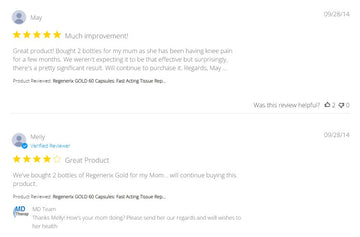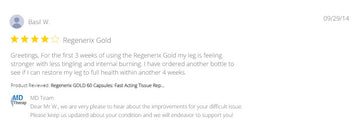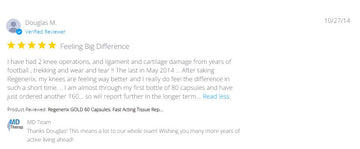Aquatic Walking: Gentle, Buoyant Conditioning for Sore Knees & Hips
by MD therapeutics on Aug 17, 2025
Why aquatic walking helps (the principles)
-
Buoyancy unloads joints: Water supports body weight, reducing ground-reaction forces on knees/hips while preserving rhythmic motion that circulates synovial fluid and eases stiffness.
-
Hydrostatic pressure & viscosity: Gentle compression can assist swelling control, while water resistance provides uniform, low-velocity strengthening without harsh impact.
-
Movement confidence: The pool’s support often lets people walk farther with less pain, building aerobic base and gait quality—useful for knee/hip osteoarthritis and patellofemoral pain.
How to start (safe setup):
-
Chest-deep water; walk tall with eyes forward and slight core brace.
-
Shorter, quicker steps (avoid over-striding); feet point straight ahead, knees track over toes.
-
10–20 minutes, 3–4×/week, adding ~5 minutes weekly toward 30–40 minutes as tolerated.
-
Keep pain ≤3/10 and resolved within 24 hours—otherwise trim time or pace and re-progress.
Limits of exercise alone
-
Systemic drivers remain: Diet, sleep, stress and metabolic health influence symptoms and recovery.
-
Flares cap load: Pain spikes can create stop-start progress without broader support.
-
Individual mechanics: Many need targeted land strength/mobility or gait retraining in addition to pool work.
-
Slow tissue remodeling: Cartilage, tendons and ligaments adapt over months—consistent loading plus recovery strategies (including nutrition) work best.
Why add nutritional correction
-
Improve circulation so working tissues receive oxygen and nutrients after sessions.
-
Promote repair by providing structural inputs (e.g., collagen peptides, hyaluronic acid) that complement the exercise signal.
-
Reduce excessive inflammation to keep training tolerable and consistent.
-
Protect tissues from oxidative and catabolic stress during rehab.
Botanicals & nutrients often paired with joint-support programs
(Blends traditional lore with published research; evidence ranges from promising to mixed. Check personal suitability and interactions with your clinician.)
Ginger (Zingiber officinale)
-
Traditional use: Ayurveda and East Asian medicine for circulation and “wind-damp” aches.
-
What studies suggest: Standardized ginger can offer modest symptom relief for some with osteoarthritis; results vary by dose and extract.
Turmeric / Curcumin (Curcuma longa)
-
Traditional use: Core Ayurvedic spice for comfort and resilience.
-
What studies suggest: Curcumin extracts (especially bioavailability-enhanced forms) can reduce knee-OA pain and improve function vs placebo.
-
Food reality: Culinary turmeric contains limited curcumin; trial-like intakes are hard to achieve via food alone.
Boswellia / Frankincense (Boswellia serrata)
-
Traditional use: Ayurveda’s shallaki resin for joints.
-
What studies suggest: Standardized extracts may improve pain and function in osteoarthritis cohorts.
Winter Cherry / Ashwagandha (Withania somnifera)
-
Traditional use: Adaptogen for recovery and musculoskeletal comfort.
-
What studies suggest: Clinical trials indicate immunomodulatory effects and symptom support in knee-pain populations.
Collagen Peptides (Type II emphasis)
-
Concept: Provide peptides that may support cartilage metabolism and connective-tissue integrity—useful alongside aquatic walking’s gentle mechanical signal.
-
Evidence: Meta-analyses report pain/function benefits in knee OA vs placebo (more high-quality trials still encouraged).
Hyaluronic Acid (oral)
-
Concept: Contributes to joint lubrication/viscosity and supports smooth movement.
-
Evidence: Recent reviews suggest oral HA is safe and can support joint comfort and function.
Cat’s Claw (Uncaria spp.)
-
Traditional use: Peruvian/Amazonian remedy for “rheumatism.”
-
Evidence: Placebo-controlled trials show short-term pain improvements in knee OA; broader evidence remains limited/mixed.
The practicality problem
-
Food-only dosing is tough: Reaching research-like intakes for turmeric/curcumin or ginger via meals is impractical day-to-day.
-
Pill burden & cost stack up: Buying six–seven separate products (ginger, turmeric, boswellia, ashwagandha, collagen, HA, cat’s claw) multiplies capsule counts and monthly spend—versus one comprehensive formula.
A convenient all-in-one option: Regenerix Gold™
If you want aquatic walking + nutrition without juggling bottles:
-
What’s inside: Hydrolyzed Type II Collagen, Hyaluronic Acid, and a proprietary blend of Ginger, Turmeric, Frankincense (Boswellia), Cat’s Claw, and Winter Cherry (Ashwagandha)—the same seven ingredients discussed above—combined to promote healthy joint and muscle function and support everyday recovery.
-
Dosing: 2–3 capsules daily.
-
Price: $98 a bottle.
-
Why it fits here: One product covering seven evidence-linked ingredients is simpler—and typically more cost-effective—than buying 5–7 separate supplements.
-
Track record: Recommended by doctors and physical therapists internationally for about a decade (individual clinician views vary).
Supplements support healthy function; they don’t diagnose, treat, or cure disease. Check interactions (e.g., anticoagulants with turmeric/ginger/boswellia) and personal suitability with your clinician.
A simple pool-walking plan for this week
-
Week 1–2: 10–15 min chest-deep walking, 3–4×/wk (steady, short steps)
-
Week 3–4: 20–30 min, 4–5×/wk; add brief 30–60 s “pick-ups” if pain ≤3/10 and settles within 24 h
-
Support moves (2–3×/wk): Pool calf raises, gentle quad/hamstring stretches, side-steps with mini-band (in water if available)
-
If soreness spikes: Reduce session time/intensity by ~20–30% and re-progress



